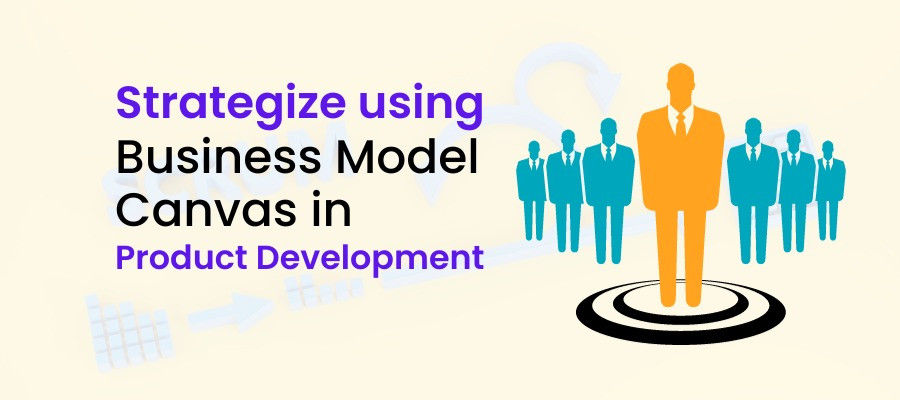Strategize using Business Model Canvas in Product Development

Do you know that agility and effective product development strategies are the true heroes to drive Agile Success? Agile methodologies, such as Scrum, have gained immense popularity over the past years. Now, most organizations are adopting them to stay competitive. However, they need to align the product development strategies to excel. The Business Model Canvas (BMC), devised by Strategize, is what they need to achieve the ultimate success. Let’s explore what the Business Model Canvas is and why it's a valuable tool for strategizing product development!
What is a Business Model Canvas?
The Business Model Canvas, often abbreviated as BMC, is a visual tool designed to help organizations understand, design, and communicate their business model. Alexander Osterwalder and Yves Pigneur developed it, and it has become a fundamental framework in the business world.
The BMC consists of nine building blocks, each representing a critical aspect of a business:
- Customer Segments: Create the target customer groups.
- Value Proposition: Define what unique value your product or service offers.
- Channels: Find an interactive way to approach customers.
- Customer Relationships: Establish the type of customer relationships to maintain.
- Revenue Streams: Identify potential areas for revenue generation.
- Key Resources: List the essential assets and resources required.
- Key Activities: Enumerate the crucial tasks and activities for the business.
- Key Partnerships: Identify external organizations or entities you will collaborate with.
- Cost Structure: Outline the operational costs associated with the business.
Why Use the Business Model Canvas to Strategize Product Development?
Now, you may be wondering how the Business Model Canvas relates to product development, especially in an Agile context. Here's why BMC is invaluable:
Alignment with Agile Principles:
Agile emphasizes customer value, iterative development, and quick responses to change. The BMC encourages a customer-centric approach by focusing on customer segments and value propositions, ensuring that product development aligns with Agile principles.
Clear Vision:
BMC provides a clear and concise representation of your business model, making it easier for Scrum Teams, Product Owners, and Developers to understand the bigger picture. This shared vision is vital for successful product development.
Adaptability:
In Agile development, change is constant. BMC allows you to quickly update and adapt your business model to accommodate changes in customer needs, market dynamics, or competitive pressures.
Collaboration:
BMC fosters collaboration among Scrum Team members, Product Owners, and other stakeholders. It encourages open discussions about the business model and helps identify opportunities and challenges.
Guidebook To Use Business Model Canvas For The Product Roadmap
Now that you understand the importance of BMC in Agile product development let's explore how to use it effectively for your product roadmap:
Start with Customer Segments and Value Proposition:
Identify your target customer segments and their unique needs. Determine the value your product will deliver to these customers. Agile Practitioners, including Scrum Masters and Product Owners, should be actively involved in this step to ensure alignment with Agile principles.
Channels and Customer Relationships:
Decide how you will reach your customers and establish relationships with them. Agile Coaches can guide you in selecting the most effective channels and communication strategies that align with Agile principles.
Revenue Streams and Cost Structure:
Clearly define how your product will generate revenue and outline the associated costs. Agile Leaders can help optimize costs while maximizing revenue opportunities.
Highlight Key Resources and Partnerships:
Identify the essential resources, activities, and partnerships required to deliver your product. Agile Developers and Scrum Teams should ensure that they have the necessary skills and tools to execute the plan efficiently.
Iterate and Validate Continuously:
Just as in Agile development, the BMC is not a static document. Regularly revisit and update it based on feedback, market changes, or new insights. Agile Training and Workshops can assist in keeping your team aligned and informed.
Alignment with Product Backlog:
Integrate the insights from your BMC into your product backlog. Create User Stories and Product Backlog Items (PBIs) that directly align with your value proposition and customer segments.
Conduct Sprint Planning:
During Sprint Planning, Scrum Teams can ensure that the Sprint Backlog aligns with the BMC's key activities and resources. As you develop your product incrementally, continuously refer to the BMC to ensure that the incremental releases are delivering the intended value to your customers.
Definition of Ready With Collaborative Review:
Define the criteria for a Product Backlog Item (PBI) to be "ready" for development. It ensures that each PBI aligns with your BMC and customer-centric focus. Conduct collaborative reviews with Agile Coaches, Scrum Masters, Product Owners, and Developers to assess the progress and make necessary adjustments.
Summing Up:
Staying Agile and customer-focused is paramount for every business. The Business Model Canvas (BMC) serves as a bridge between Agile principles and sound business strategy. By using the BMC in your product development process, you can align your teams, adapt to change, and continuously deliver value to your customers. Agile training, coaching, and collaboration among Agile Practitioners, Scrum Teams, and key stakeholders will ensure the successful integration of BMC into your Agile product development framework. Embrace the power of BMC, and watch your product development strategies thrive in the Agile world.
Reference:
https://www.scrum.org/resources/blog/your-unfit-product-goal-and-product-goal-canvas-making-your-scrum-work-28



